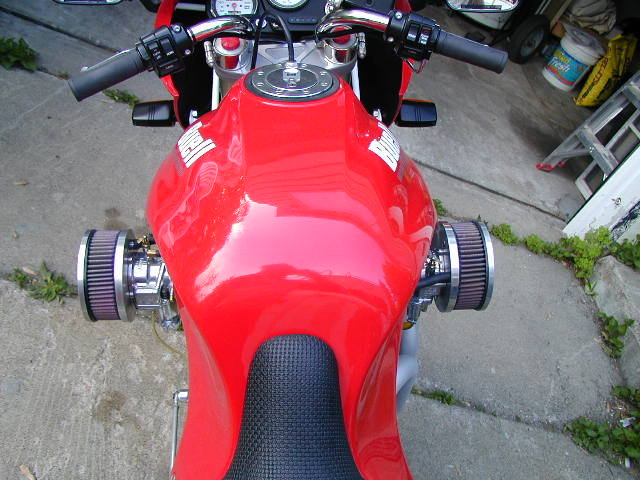
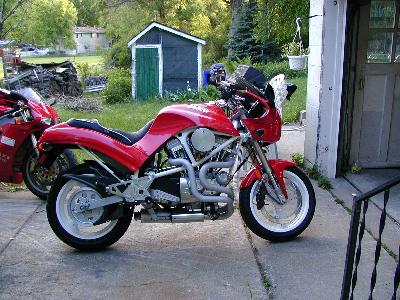
A dual-carb Buell and the development process
Mike Roland has been building H-D engines that use Nitro-Methane fuel, for many years.
Although he has owned several Japanese motor-cycles over the years, and appreciates their strong points, he has concentrated on Harley-Davidsons. I think that Mike has always liked winning, as an under-dog. That's why he stuck with Harleys and turned to nitro.
Roland, working with Schumaker Racing, designed the 'Top-Fuel' Harley heads that many of the IHRA Nitro Harley competitors are using this includes Jay Turner, who is the class champion this year. (With more teams next year.)
If you'd like to contact Mike Roland, here is a link to his E-mail; click here
If you'd like to contact me, Doug Lofgren at Motorcycle Performance Services, go back to the homepage; go back
Everyone who has seen these heads, knows that they are the best Harley-Davidson ports they have ever seen.
When he was designing the 'Top-Fuel' ports he also designed some for a 4.5" bore Pro-Stock bike, and street heads (with larger valves) for 4" to 4.5" bore, as well as the heads we put on the 'Project' Buell. These are also configured for a 'Big-Twin' Evo.
Both the Sportster and 'Big-Twin' heads are set up for 3.5" to 3.8125" bore.
They have 1.94" intake and 1.610" exhaust valve, while the 'big-bore' street heads have 2.125" inlet and 1.75" exhaust.
We have been using the Dynomation engine simulation program from the beginning (a long time now) for the designs of this concept. Now we use it from a good starting point and to look at the effects of the changes we are planning.
We compare the changes we plan, with the dyno tests of configurations we've already run (on both the simulation and the dyno.) When we get a correlation between the two we can be fairly confident that small changes can be predicted accurately.
The separate inlet Buell is a 'proof-of-concept' exercise. For the application of 'tuned' inlet on a 45degree V-twin.
Our starting point for this project is a stock 1995 Buell S2. Unlike the later M1 and S1, the S2 has stock Sportster cams and larger (heavier) flywheels. (This has some effect on power since we're using a Dynojet inertial dyno.)
In this iteration the cams (supplied by Andrews, to Mike's specs) are almost the same lift and duration as an S1. The lobe centers are a little wider, to work with the separate inlet tracts. (That's one aspect we worked out with the Dynomation program.) The compression ratio is 10:1, like an S1.
We used 2 S&S 'E' carbs. (these were supplied by S&S, thru Dan Kinsey, R&D Manager) The jetting requirement for separate inlet tracts is very different than for a 'Y' manifold H-D. (That would be a big part of this process.) You just couldn't guess what changes would be needed. Below is a shot from the rider's seat, of the dual carb set-up. No forward mounted controls with this combination! And, a side view of the bike. Fits in well with the Ducatis.


We started with a test of the stock S2, but the top-end was breaking-up from some ignition problems, a Power-Arc Ignitions ignition system solved that. So, the first good test we got was using a single S&S 'G' carb on the 'Y' manifold, and a stock pipe with a Super-Trapp slip-on muffler with a closed end cap and 30 discs.
Dynomation predicts power at the crankshaft. Harley-Davidsons "101HP" kit for the Buell usually puts out 84HP on a Dynojet dynamometer. If we use this 84% factor (84/101=.8317), 125 HP from the program should make 105HP on the dyno which is just where we are.
Below is the early dyno chart compared to a later run after much tuning and fiddling.
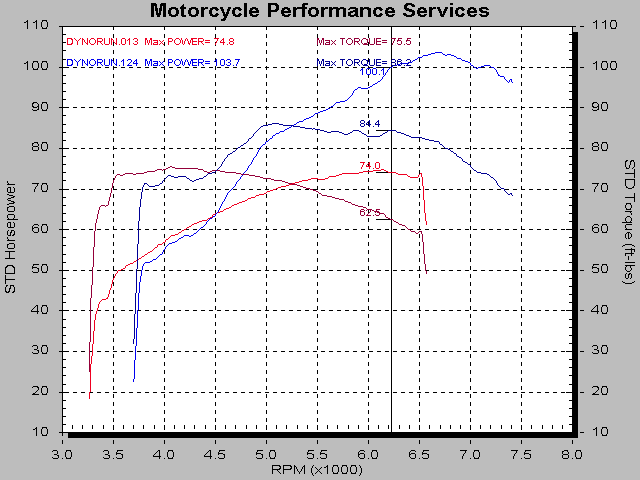
I've put the cursor at a little over 6200 RPM to show the drastic increase in torque at a usable RPM.
Next is the Dynomation prediction for the configuration that we just finished.
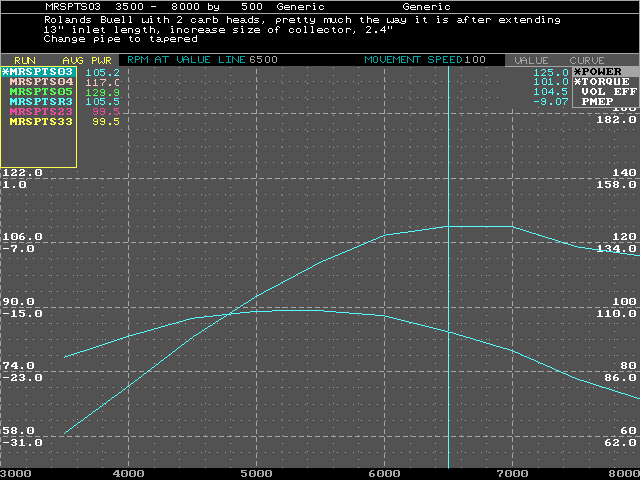
Keep in mind that a lighter flywheel (as the S1 '101HP kit' uses) will add power by virtue of not storing it. So, I would expect that this heavy flywheel (S2, stock) configuration would indicate a bit less power on a Dynojet dyno.
You might notice the number of the latest run. It's 124, just in case you're thinking that using a computer program eliminates all of the work.
Test #061 shows the results of 9" inlet length and the stock S2 exhaust pipe.
Test #102 was run with a 13" inlet length, notice the torque improvement at 5200 RPM and the useless rise at 7500 RPM, which may or may not occur with the configuration as run #061, nevertheless it is too high an RPM to be usable reliably.
Finally, test # 124 with the right length exhaust pipe and velocity stacks installed with no air-cleaners. I think the weight of the air-cleaners was causing some problems with vibration and float level, that's why we removed the air-cleaners.
There is a big difference in torque at 4400 RPM and at 5000 RPM. Certainly the pipe length has had a significant effect.
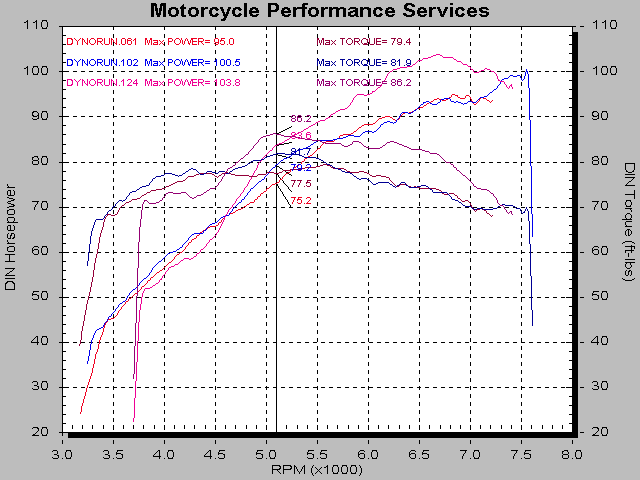
The following chart shows a 1999 X1 with Super-Trapp plotted with our twin-carb set-up.
Note that the 1999 X1 has lighter flywheels, better crankcase oil scavenging/scraping, and fuel injection.
This compares engines with a comparable state of tune, and the twin-carb stands up pretty well.
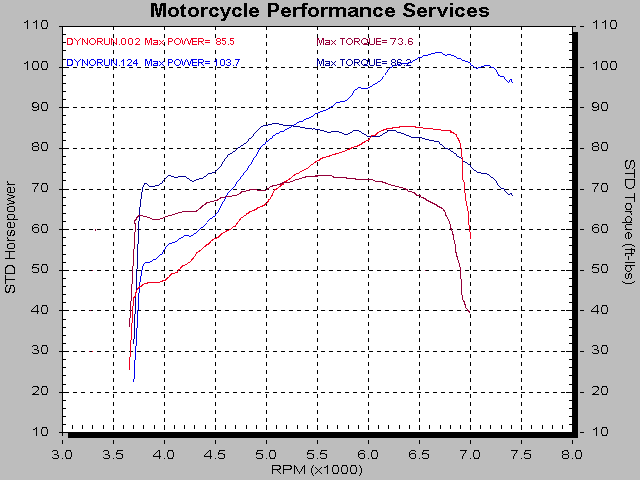
After test #124 Mike went home and made some different air cleaners and fabricated some new manifolds. Since we had extended them with phenolic spacer blocks, the inlet manifold was a little uneven.
He brought the bike back and mentioned to me that the right carb (rear cylinder) was making a weird noise. Indeed it did, but we proceeded with the testing. The good news is that the results were as good as the results without the air cleaners.
But, the carburation was acting strange, much too rich in the mid-range and some other strange indications. We wrote that off to the change in air cleaner configuration.
Finally we decided to check the compression. The rear cylinder was down compared to the front.
Then we checked the leak-down! 82% on the rear cylinder, our testing was done for the day.
Mike found the rear cylinder inlet valve was warped by 0.010" at one area of the face.
He replaced the inlet valves, adjusted the squish clearance to be the same on both cylinders, and re-assembled the engine.
Back to the dyno at a later date. The first few runs were very encouraging, but we found that the jetting needed to be adjusted some more (every time we made a change it had to be adjusted one way or another.)
We dropped the mains one more time and the power at the top dropped drastically. The indication from the CO meter was that the mid-range was OK but the top was lean. We knew that the previous runs had suffered from rich mid-range, but we didn't realize how much it had carried over to the top-end.
A couple things should be noticed in the following chart;
Runs number 135 and 137 are with the same configuration. In run 137 the engine is significantly hotter than in run 135.Run 135 shows a smoother top-end power than run 137.
Run 139 is with the main jet dropped 2 sizes, and shows much better power at the low end (of the chart) (that would be at the torque peak), but break-up at the top from being too lean.
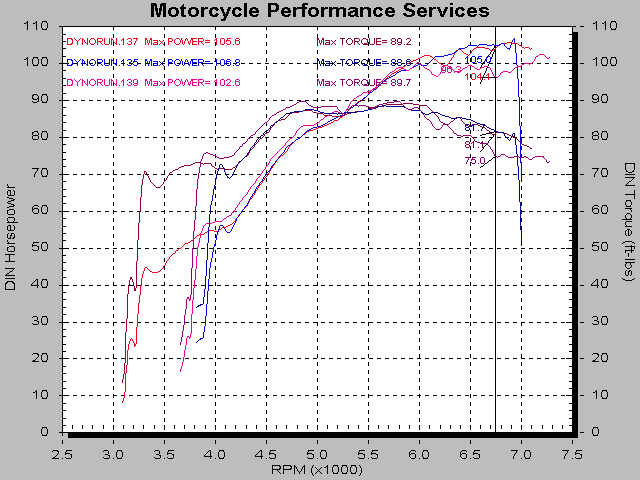
As a result of these tests, we took the carbs apart again and changed the emulsion tube holes and the main air-bleed (as well as the intermediate jets) and went back to the previous main jets.
The throttle response at low load was much improved and the power was very nice.
Dig this, 93.3 lb/ft of torque!
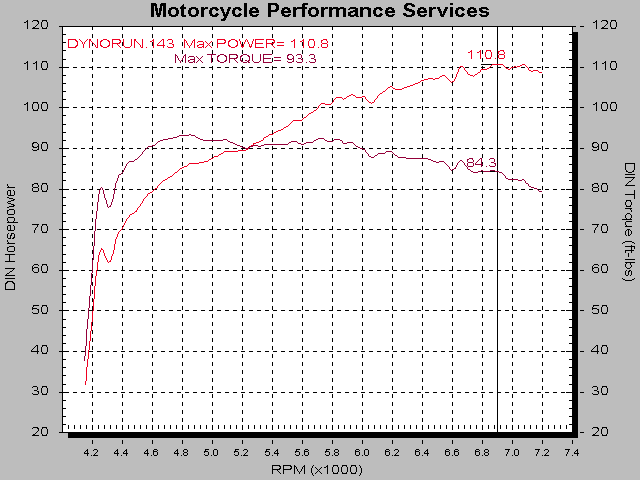
From the previous tests we came to the startling conclusion that the temperature of this thing has a much larger effect on the power and torque, than we realized. And that is in addition to its effect on the jetting. You can sit back in your computer chair and say 'I knew that' and so did we, but the magnitude of the effect is surprising.
Finally we decided to do one 5th gear run (less inertia loss) with the top-end really cool and this was the result.

You will notice the break-up at the top-end of the chart. We should have gone up several sizes on the main jet for this run. Further pointing out the effects of heat on the engine.
But, who cares? 98 lb-ft of torque and 114HP from a 1206cc Harley engine! (Its 1206cc because Mike used 0.005" O.S. pistons.)
Next Mike is going to lighten the flywheels, install a better oil scavenging system, and put in some cams better suited to the cylinder head characteristics. The 0.500" lift cams that are in there right now, give a Lift/Diameter ratio of .254. The 0.625" lift cams will put it at .3175.
Stay tuned.
Alright, so he didn't get to the flywheels next. Mike put in a set of 1.745:1 rocker-arms. That increases the lift to 0.540" or something like that. We know the ports will like it, just how much the engine would like it is the question.
Today, (March 10) he brought it over to the shop and we commenced to pound on it some more. By the end of the day we had 178 dyno runs on the poor thing. But don't be too sad for the Buell, it can take care of itself!
I've had a new Dynojet air/fuel ratio meter for a little more than a month now and we haven't had a chance to use it on the Buell, this would be it.
As I've said earlier in this article, we have had to change the calibration of these carbs nearly every time we've made improvements, and we've made a few. The new oxygen sensor and related software was a big help in re-calibrating the S&S 'E's this time. We may have the best calibration we've done so far, and it pays off in torque.
Our first runs of the day showed that the jetting was, again, way off. Also, you will notice a couple spots were the data is missing. I don't know were that comes from but it occurs occasionally. It's probably caused by nasty ignition spikes or the pick-up bouncing off the head.
At this point I should say that this dyno data anomaly can be written off as a 'shit happens' incident. However, I don't generally subscribe to that philosophy. Usually you allow 'shit' to happen or you cause 'shit' to happen.
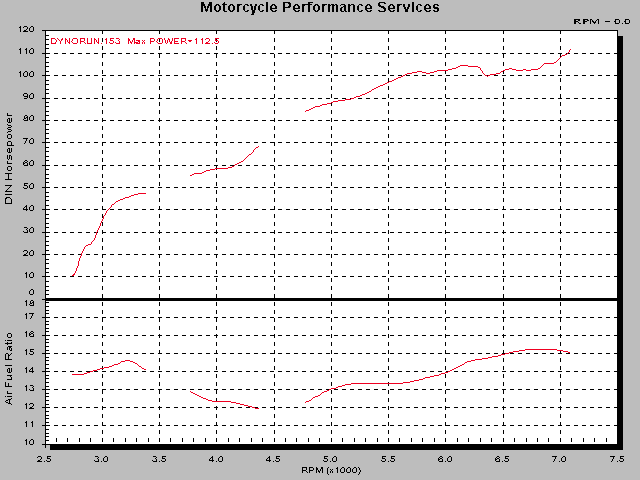
Anyway, the new Dynojet software can display the air\fuel ratio as a separate chart below the power chart. Cool huh?
You will notice that the A/F ratio is quite lean (12.5:1 being 'best power mixture') at the top, which coincides with the misfire at the top end of the power curve.
As we increased the main jet size the low end of the curve got richer, so we had to do another major re-calibration. This always turns into an 'all day sucker'!
It turns out that in one of this engines previous lives it had been too lean down low and rich at the top, so we had added a hole in the emulsion tube to help tip the response. This iteration was the opposite, and we had to solder holes shut and make another in a different location. The good news is that the dual carbs and the correct length inlet manifolds make working on the carbs a breeze.
As we leaned out the low end of the curve the torque started coming up. For the last two runs we cooled the top-end a little (it can get blistering hot after a few dyno runs) and gave it a 5th gear pull. The results are below.
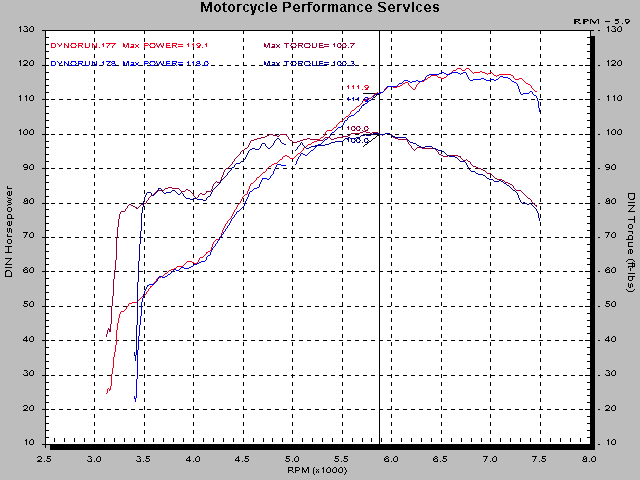
The first of the two runs is a little cooler and it likes the richness at 4000-4500 RPM more than the next run, but they both make 100+ lb/ft of torque. The specific torque (torque per unit of displacement) is 1.3514 lb/ft per cubic inch, or 83.33 lb/ft per liter.
By these standards a 96 CI H-D would make 130 lb/ft of torque. A 113 CI S&S engine would make 152 lb/ft.
Try this calculation on your bike and see how it stacks up! Torque divided by displacement (in liters)= ???
The following chart compares our early run (with good ignition and a single S&S 'G' carb) to our latest result.
Both of us are pleased but, actually, a little surprised by the results. At 6000 RPM the power increase is 55%
Look at the chart below 4000 RPM. The power improvements down there are about what you'd expect for 1 point in compression, and a little improvement in the cam. All of the rest is 'tuning', both inlet and exhaust.
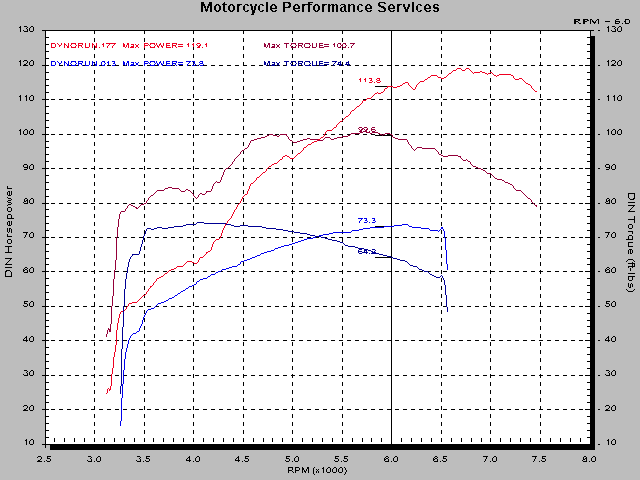
This is a 10:1 CR, 1200CC (that's 74 cubic inches) Sportster engine. All of the testing has been done with 92 Octane Amoco Ultimate pump gas, and it doesn't ping, ever. I'm salivating about what we can do when the Titanium rods, lightened crank and crankcase scavenging control are done. What if we add some compression? Displacement?
What I really want to do is shorten the stroke and rev it just a little more. But, we're afraid for the life of the crankcases.
Maybe this one should serve some time on the street, it really is fun to ride.